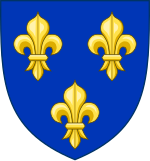
François-Dominique Toussaint Louverture also known as Toussaint L'Ouverture or Toussaint Bréda; 20 May 1743 – 7 April 1803) was a Haitian general and the most prominent leader of the Haitian Revolution. During his life, Louverture first fought and allied with Spanish forces against St. Dominican Royalists, then joined with Republican France, becoming Governor-General-for-life of Saint-Domingue, and lastly fought against Napoleon Bonaparte's Empire. As a revolutionary leader, Louverture displayed military and political acumen that helped transform the fledgling slave rebellion into a revolutionary movement. Louverture is now known as the "Father of Haiti".

Jean-Jacques Dessalines was the first Haitian Emperor, and leader of the Haitian Revolution, and the first ruler of an independent Haiti under the 1805 constitution. Initially regarded as governor-general, Dessalines was later named Emperor of Haiti as Jacques I (1804–1806) by generals of the Haitian Revolutionary army and ruled in that capacity until being assassinated in 1806. He spearheaded the resistance against French massacres upon Haitians, and eventually became the architect of the 1804 Haitian Genocide against remaining French residents of Haiti, including supporters of the revolution. He has been referred to as the father of the nation of Haiti.
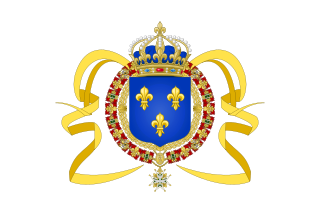
Saint-Domingue was a French colony in the western portion of the Caribbean island of Hispaniola, in the area of modern-day Haiti, from 1659 to 1804. The name derives from the Spanish main city on the island, Santo Domingo, which came to refer specifically to the Spanish-held Captaincy General of Santo Domingo, now the Dominican Republic. The borders between the two were fluid and changed over time until they were finally solidified in the Dominican War of Independence in 1844.

Alexandre Sabès Pétion was the first president of the Republic of Haiti from 1807 until his death in 1818. One of Haiti's founding fathers, Pétion belonged to the revolutionary quartet that also includes Toussaint Louverture, Jean-Jacques Dessalines, and his later rival Henri Christophe. Regarded as an excellent artilleryman in his early adulthood, Pétion would distinguish himself as an esteemed military commander with experience leading both French and Haitian troops. The 1802 coalition formed by him and Dessalines against French forces led by Charles Leclerc would prove to be a watershed moment in the decade-long conflict, eventually culminating in the decisive Haitian victory at the Battle of Vertières in 1803.

In the context of the history of slavery in the Americas, free people of color were primarily people of mixed African, European, and Native American descent who were not enslaved. However, the term also applied to people born free who were primarily of black African descent with little mixture. They were a distinct group of free people of color in the French colonies, including Louisiana and in settlements on Caribbean islands, such as Saint-Domingue (Haiti), St. Lucia, Dominica, Guadeloupe, and Martinique. In these territories and major cities, particularly New Orleans, and those cities held by the Spanish, a substantial third class of primarily mixed-race, free people developed. These colonial societies classified mixed-race people in a variety of ways, generally related to visible features and to the proportion of African ancestry. Racial classifications were numerous in Latin America.
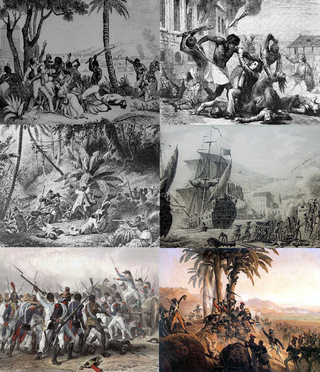
The Haitian Revolution was a successful insurrection by self-liberated slaves against French colonial rule in Saint-Domingue, now the sovereign state of Haiti. The revolt began on 22 August 1791, and ended in 1804 with the former colony's independence. It involved black, biracial, French, Spanish, British, and Polish participants—with the ex-slave Toussaint Louverture emerging as Haiti's most prominent general. The revolution was the only slave uprising that led to the founding of a state which was both free from slavery and ruled by non-whites and former captives. The successful revolution was a defining moment in the history of the Atlantic World and the revolution's effects on the institution of slavery were felt throughout the Americas. The end of French rule and the abolition of slavery in the former colony was followed by a successful defense of the freedoms the former slaves had won, and with the collaboration of already free people of color, of their independence from white Europeans.

Sugar plantations in the Caribbean were a major part of the economy of the islands in the 18th, 19th, and 20th centuries. Most Caribbean islands were covered with sugar cane fields and mills for refining the crop. The main source of labor, until the abolition of chattel slavery, was enslaved Africans. After the abolition of slavery, indentured laborers from India, China, Portugal and other places were brought to the Caribbean to work in the sugar industry. These plantations produced 80 to 90 percent of the sugar consumed in Western Europe, later supplanted by European-grown sugar beet.
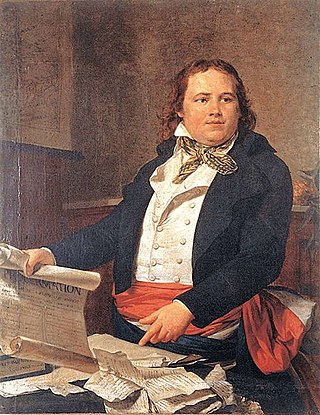
Léger-Félicité Sonthonax was a French abolitionist and Jacobin before joining the Girondist party, which emerged in 1791. During the French Revolution, he controlled 7,000 French troops in Saint-Domingue during part of the Haitian Revolution. His official title was Civil Commissioner. From September 1792, he and Polverel became the de facto rulers of Saint-Domingue's non-slave population. Because they were associated with Brissot’s party, they were put in accusation by the convention on July 16, 1793, but a ship to bring them back in France didn’t arrive in the colony until June 1794, and they arrived in France in the time of the downfall of Robespierre. They had a fair trial in 1795 and were acquitted of the charges the white colonists brought against them. Sonthonax believed that Saint-Domingue's whites were royalists or separatists, so he attacked the military power of the white settlers and by doing so alienated the colonial settlers from their government. Many gens de couleur asserted that they could form the military backbone of Saint-Domingue if they were given rights, but Sonthonax rejected this view as outdated in the wake of the August 1791 slave uprising. He believed that Saint-Domingue would need ex-slave soldiers among the ranks of the colonial army if it was to survive. On August 1793, he proclaimed freedom for all slaves in the north province. His critics allege that he was forced into ending slavery in order to maintain his own power.
Afro-Caribbean people or African Caribbean are Caribbean people who trace their full or partial ancestry to sub-Saharan Africa. The majority of the modern Afro-Caribbean people descend from the Africans taken as slaves to colonial Caribbean via the trans-Atlantic slave trade between the 15th and 19th centuries to work primarily on various sugar plantations and in domestic households. Other names for the ethnic group include Black Caribbean, Afro or Black West Indian or Afro or Black Antillean. The term Afro-Caribbean was not coined by Caribbean people themselves but was first used by European Americans in the late 1960s.
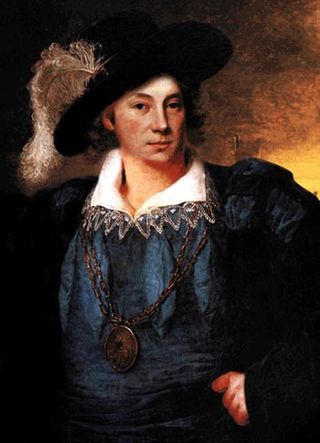
Laurens Cornelis Boudewijn de Graaf was a Dutch pirate, mercenary, and naval officer in the service of the French colony of Saint-Domingue during the late 17th and early 18th century.

Jean-Baptiste du Casse was a French naval officer, privateer, slave trader and colonial administrator who served as the first governor of Saint-Domingue from 1691 to 1700. Born on 2 August 1646 in Saubusse, France to a Huguenot family, du Casse enlisted in the French merchant navy before joining the French East India Company and the Compagnie du Sénégal. He subsequently enlisted in the French Navy and took part in several victorious expeditions during the Nine Years' War in the West Indies and South America.
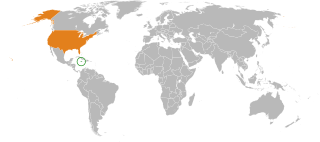
The United States maintains close and productive relations with Jamaica.

In the history of the Dominican Republic, the period of Era de Francia occurred in 1795 when France acquired the Captaincy General of Santo Domingo, annexed it into Saint-Domingue and briefly came to acquire the whole island of Hispaniola by the way of the Treaty of Basel, allowing Spain to cede the eastern colony as a consequence of the French Revolutionary Wars.

John Perkins, nicknamed Jack Punch, was a British Royal Navy officer. Perkins was perhaps the first mixed race commissioned officer in the Royal Navy. He rose from obscurity to be a successful ship's captain in the Georgian Royal Navy. He captained a 10-gun schooner during the American War of Independence and in a two-year period captured at least 315 enemy ships.

The Battle of Jean-Rabel consisted of two connected minor naval engagements of the French Revolutionary Wars and the Haitian Revolution. The first engagement saw an overwhelming British Royal Navy force consisting of two ships of the line attack and destroy a French Navy frigate in Moustique Inlet near the town of Jean-Rabel on the Northern coast of the French colony of Saint-Domingue. The second engagement took place four days later when a force of boats launched from a British frigate squadron attacked the town of Jean-Rabel itself, capturing a large number of merchant ships in the harbour that had been seized by French privateers.
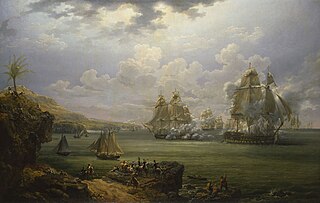
The blockade of Saint-Domingue was a naval campaign fought during the first months of the Napoleonic Wars in which a series of British Royal Navy squadrons blockaded the French-held ports of Cap-Français and Môle-Saint-Nicolas on the northern coast of the French colony of Saint-Domingue, soon to become Haiti, after the conclusion of the Haitian Revolution on 1 January 1804. In the summer of 1803, when war broke out between the United Kingdom and the French Consulate, Saint-Domingue had been almost completely overrun by Haitian Armée Indigène troops led by Jean-Jacques Dessalines. In the north of the country, the French forces were isolated in the two large ports of Cap-Français and Môle-Saint-Nicolas and a few smaller settlements, all supplied by a French naval force based primarily at Cap-Français.
White Haitians, also known as Euro-Haitians, are Haitians of predominant or full European descent. There were approximately 20,000 whites around the Haitian Revolution, mainly French, in Saint-Domingue. They were divided into two main groups: The Planters and Petit Blancs. The first white Europeans to settle in Haiti were the Spanish. The Spanish enslaved the indigenous Haitians to work on sugar plantations and in gold mines. European diseases such as measles and smallpox killed all but a few thousand of the indigenous Haitians. Many other indigenous Haitians died from overwork and harsh treatment in the mines from slavery. Many white people who settled in Haiti were killed or fled during the Haitian Revolution.
The expression ‘’Irish of Nantes’’ denotes a community formed in the 17th century and of great importance in the 18th century. It was originally composed of Jacobite political refugees from Ireland fleeing the Glorious Revolution of 1688. This community eventually extended to the ports of Bordeaux and La Rochelle as well as to the French colony of Saint-Domingue.

The Law of 4 February 1794 was a decree of the French National Convention which abolished slavery in all French colonies.

The Léopardins, also called the Assembly of Saint-Marc or the “Faction des 85”, were the elected members of the self-proclaimed Assembly in Saint-Domingue who tried to resist the reforms of the French Revolution, claiming to be above the Governor General. They sailed to France aboard the military ship Le Léopard to try to impose the Secession of Saint-Domingue there. The Léopardins were successors to the Club de Hôtel de Massiac, who were also worried about plans to give more freedoms to mulattoes or blacks.
